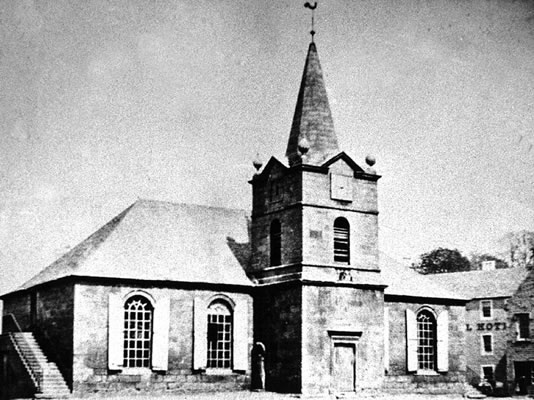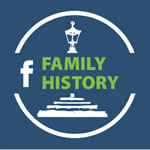Researched Articles
On occasion we research items of interest on the history of Cumnock and present them here.
Researched by Bobby Grierson
 Andrew Carnegie was a Scottish-American industrialist who led the enormous expansion of the American steel industry in the late 19th century. He built a leadership role as a philanthropist for the United States and the British Empire. During the last 18 years of his life, he gave away to charities, foundations, and universities about $350 million (in 2015 about $13.7 billion) – almost 90 percent of his fortune. His 1889 article proclaiming "The Gospel of Wealth" called on the rich to use their wealth to improve society, and it stimulated a wave of philanthropy.
Andrew Carnegie was a Scottish-American industrialist who led the enormous expansion of the American steel industry in the late 19th century. He built a leadership role as a philanthropist for the United States and the British Empire. During the last 18 years of his life, he gave away to charities, foundations, and universities about $350 million (in 2015 about $13.7 billion) – almost 90 percent of his fortune. His 1889 article proclaiming "The Gospel of Wealth" called on the rich to use their wealth to improve society, and it stimulated a wave of philanthropy.
Carnegie was born in Dunfermline, Scotland in 1832 and immigrated to the United States with his parents in 1848. Carnegie started work as a telegrapher and by the 1860s had investments in railroads, railroad sleeping cars, bridges and oil derricks. He accumulated further wealth as a bond salesman raising money for American enterprise in Europe. He died in 1919.
In 1881, at the age of 46, he embarked on what only can be called a ‘Road Trip’ from Brighton to Inverness. On July 18th Carnegie travelled through Cumnock with his travelling party, including his mother Margaret, and companions Jeannie Johns, Alice French, David McCargo and wife, Alex and Agnes King, Benjamin Vandervot, Henry Phipps and George McCandless – all on a coach and four horses!
They had left the Queensbury Hotel in Sanquhar for Cumnock earlier that day and arrived in Cumnock hours later and stayed at the Dumfries Arms Hotel where the landlord James Murray and his two sisters, Anne and Margaret, made them welcome and provided them with a luncheon for the coach which they drove to Douglas Water for the day.
Carnegie writes in his diary: - “Mr Murray and his handsome sisters will long be remembered as model hotel-keepers. They made our stay most agreeable.”
On their return they noticed a women driving up in a stylish open carriage who made her apologies for intruding but said that she had noticed their coach and as these were rarely seen in Cumnock was curious to know who they were and where they were going. They duly answered and she introduced herself as Lady Jane Stuart Monteth from nearby Mansfield House in New Cumnock.
That evening James Murray took the Carnegie party to Cumnock Bowling Green where many of them saw the game for the first time. Carnegie writes: - “Great excitement prevails when the sides are evenly matched. It is like the curling pond, a perfect republic. There is no rank upon the ice or upon the green. The postman will berate the provost for bad play at bowls, but touch his hat respectfully to him on the pavement. A man may be even a provost and yet not up to giving them a ‘Yankee’, when called for. We were curious to know what a ‘Yankee’ shot was, for we heard it called for by the captains every now and then. We were told that this was a shot, which ‘knocked all before it, and played the very devil.’ That is not bad.”
The next day Carnegie remained in Cumnock while some of his party drove to Ayr to see the sights of Burns and returned that evening. Meanwhile Carnegie writes: - “Our walks about Cumnock were delightful, and we left Mr Murray’s care with sincere regret.”
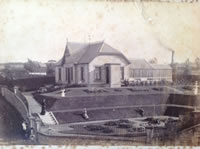 Leaving Cumnock the following day they stopped at John Ballantines photographic studio on Ayr Road. “Passing out of the town this morning, we stopped at the prettiest little photographic establishment we had ever seen, and the artist succeeded in taking excellent views of the coach and party. It was done in an instant; we were taken ere we were aware. A great thing, that new process; one has not time to look his very worst, as sitters usually contrive to do, ladies especially.”
Leaving Cumnock the following day they stopped at John Ballantines photographic studio on Ayr Road. “Passing out of the town this morning, we stopped at the prettiest little photographic establishment we had ever seen, and the artist succeeded in taking excellent views of the coach and party. It was done in an instant; we were taken ere we were aware. A great thing, that new process; one has not time to look his very worst, as sitters usually contrive to do, ladies especially.”
They attracted quite a crowd on Ayr Road and made their way on to Douglas via Lugar. There was some concern about their stay at the Douglas Arms Hotel there as the hotel was full to overflowing with officers of the voluntary regiment that was encamped there. They had sent a telegram asking the landlord to find alternative accommodation but while coming through Lugar they were stopped.
“While passing through Lugar, a pretty young miss ran out of the telegraph office, and holding up both hands, called: ‘Stop! It's no aff yet! It’s no aff yet!’ A message was coming for the coaching party.”
It transpired that some of the officers had given up their rooms for the Carnegie party. They stayed in Douglas overnight and next day made their way on their travels to Inverness.
Sources
Carnegie A, Our Coaching Trip, Brighton to Inverness, 1882, New York
Wikipedia: https://en.wikipedia.org/wiki/Andrew_Carnegie, Dec 2015
Scotsman, Friday 16th January 1891, John Ballantine Obituary
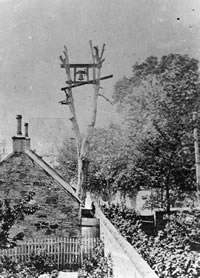 Researched by Bobby Grierson
Researched by Bobby Grierson
When the old Parish Church of 1745 was demolished in 1864 to make way for the present Parish Church in the square, people wanted to save the old church bell and the old weathercock which was on top of the old Adam church spire.
The bell was removed from the belfry and hung on a plane tree at the foot of The Strand. It was rung daily at 5:30am and 8:00pm by the bellman and gravedigger Hugh McClellan.
The bell became redundant when a new bell was donated to the new Church. It hung on the bell tree at the bottom of the Strand until the tree was deemed unsafe and cut down in 1872. It was then was transferred to the belfry of the new public school where it was installed, with the 80 year old Hugh McClellan climbing up to check that it was properly housed.
The ornate bell dates from 1697 and was cast by Quirinus de Visscher of Rotterdam and is just over 20 inches in diameter, of good casting and ornately decorated with geometric designs and a hunting scene around the border. This bell is now kept in the foyer of Cumnock Old Parish Church in the Square.
The weathercock was also rescued and installed on the gable-end of the Dumfries Arms Hotel stables, which were situated opposite the hotel in Glaisnock Street. It remained there for a 100 years until the stables were demolished in 1965 (there is a garage there now), then it was donated to the Baird Institute and appeared on the cover of John Strawhorn's New History of Cumnock published in 1966 for the Burgh Centenary Celebrations.
Grace Dickie McKerrow (1850-1906) was born in 1850, the fourth child of William McKerrow (b.1815 d.1855) and Margaret Bryson. Grace was unmarried and had her own home in Ayr when her Aunt Grizzel, her father’s half-sister who had married William Lennox, a farmer, in 1863, died after an illness in 1904. William Lennox had been ill at the same time. Grace, who had been looking after her Aunt before her death, was pressed by her to continue to look after Mr. Lennox. This Grace reluctantly agreed to do. She sold her home; except for a box of books she gave to a friend, and moved to Cumnock as housekeeper to the then deaf, elderly, childless, and retired William Lennox.
The household at "Woodside", Cumnock, consisted of William Lennox, Grace Dickie McKerrow and Elizabeth Thorburn, a domestic servant of fourteen years, when on Monday 19, November 1906, a parcel came by post addressed to Mr. Lennox. This contained an iced shortbread in a tin with a card bearing "With happy greetings from an old friend". Grace offered a piece of shortbread to Miss Thorburn, but she had a toothache so she declined the offer. The shortbread was served on the evening of Friday the 23rd, when Mrs Bain, a neighbour was present. Its somewhat bitter taste was noticed but this did not stop all four from eating their pieces, in fact Grace had two pieces. Shortly after, all felt pain, and Miss Thorburn, least affected, perhaps because she had a very small piece, was sent to fetch Dr. Robertson.
Within an hour and a quarter, Grace had died in great pain, and the Doctor realising it was from poison sent for two other Doctors, McQueen, and Armitage. The police were called. On the 28th, five days later, Thomas Mathieson Brown of New Cumnock was arrested; the handwriting on the card provided the clue. Mr. Brown was also retired. A short, bearded man, of about 44 years, he had until shortly before, been manager of the Lanemark Colliery, New Cumnock, retiring for health reasons. He was married to a niece of William Lennox and had attended Grace’s funeral: his wife nursed Mr. Lennox back to health.
Following a preliminary hearing on 8th March, the case against Brown was heard before five Judges in the Court of Judiciary, Edinburgh, on 18th, 19th and 20th March 1907. It was by then known that Brown had a history of epilepsy for some forty years. and had shown signs of insanity. In his summing up, the Lord Justice-General said that the first question for the Jury to decide was whether Brown was insane now. Only if they found him sane had they to consider whether or not he was guilty, and if guilty, was he insane at the time of the crime.
At the trial evidence was brought to show that Brown, had both icing sugar and poison in his house: the strychnine was in form of a rat poison known as Rough on Rats. Dr. Littlejohn of Edinburgh, who was later Knighted, gave evidence of finding strychnine in the icing but not in the shortbread, it was present also in the organs and blood samples received from Dr. McQueen, who had carried out the post mortem examination. There was no evidence to show that Brown himself had iced the shortbread, which was apparently confectioner-made and sold undecorated. The shortbread parcel had been posted in Kilmarnock in the course of a roundabout railway journey from Glasgow, where Brown had paid for and used a bathroom at the Conservative Club in Bothwell Street, of which he was a member. The handwriting was identified, as that of Brown`s, who pled not guilty. William Lennox, to whom questions had to be put to writing, testified that Brown could not have known of his testamentary dispositions.
Two medical experts from Glasgow gave evidence concerning forms of long term epilepsy for the prosecution. It was known that Brown had had a number of delusions. Brown’s counsel, Mr. Hunter, claimed that the precedent by which the case was being conducted was in fact unsound. He called no medical evidence, and clearly wished to fight the case on a question of guilt rather than sanity. The jury, which had been put up at the Balmoral Hotel and had been refreshed at the judge’s orders by a drive on the morning of the last day before coming to court, retired for forty minutes. They returned the Verdict that the accused was "now insane" by a majority believed to be 11 to 4; the Lord Justice-General told the Jury he thought their conduct was "perfectly right".
Brown was ordered to be detained during His Majesty`s pleasure. The position was that if Brown had instead been found guilty but insane, he might conceivably been released from detention if later his condition appeared to improve, on the application of his own legal advisors.
This affair known as the Cumnock Poisoning Case, caused much astonishment, interest, and sympathy, around Cumnock and New Cumnock particularly, and was fully reported in the "Scotsman". As far as William Lennox was concerned it was very much a Family affair. Most people believed that Brown was after his wife’s Uncle’s money, he had said that they had expectations from that quarter. His wife was a favourite of William Lennox. Grace was well liked and respected. The "Scotsman" referred to her as a "lady of much intelligence and a rare amiability of character" (26 November 1906) Her family was left to mourn her death with feelings, which can only be imagined. A younger member wrote in a letter, which has survived, that she would dearly have liked to get her hands on Brown.
Devotees of Detective fiction may be interested to know that the newspaper reports of Graces’s murder were believed to have given Dorothy Sayers the idea for her book "The Five Red Herrings”, the plot of which involved a poisoning and a roundabout railway journey. (Excerpt from the book "Your Kin and mine a story of the McKerrows" by Alexander "Sandy" McKerrow)
 Researched by Kay McMeekin
Researched by Kay McMeekin
In 1892 an action at Ayr Sheriff Court attracted a lot of public interest and was widely reported in the press.
A servant from Cumnock, Marion McCulloch aged 41, sued Gilbert Murray a stockman and grazier aged about 40 for breach of promise of marriage. She sued for damages of £1000. Many local people were either called to make a deposition or were mentioned in the trial.
Marion was born in Dailly, Ayrshire about 1850. Her parents were James McCulloch and Marion Murdoch. She was brought up by her grandmother Euphemia McCulloch living at Roadside in Cumnock. Her grandmother died in 1879 and the informant was her son in law Adam B Todd a well known person in Cumnock; an accountant, auctioneer, and journalist who lived at Breezyhill Cottage in Glaisnock Street and who was married to Marion’s aunt Ann McCulloch.
Gilbert Murray was at the fourth son of James Murray and Sarah Lang of Skerrington Farm in Cumnock. He was born on 29 Nov 1852. The case began on June 21st 1892 before Sheriff Orr Paterson at Ayr.
Marion had worked for the Murrays at Skerrington in the 1870s then briefly for a Mr Annan before going to the household of photographer John Ballantine who was single and lived with his brother’s family at 49 Glaisnock Street. (She was there in the 1881 and 1891 censuses). John Ballantine died in January 1891. She was leaving the Ballantine’s after 16 and a half years service and had no home to go to, other than her aunt Mrs Todd. This is why she was pressing him to marry in 1891.
Marion and Gilbert had been courting for 15-20 years. He had taken her to the Glasgow Exhibition in 1888 and to the Burns Monument in Ayr). He visited her on Sundays at her aunt’s house and walked her back to the Ballantines. Mr A B Todd said he looked upon them as engaged persons. Mr Todd had asked Mr Murray about his intentions some 8 years before and Mr Murray said he would “put Marion all right”.
Her aunt Mrs Todd said a Mr Armstrong from America had visited Marion recently but there was no arrangement made. Marion also said that Mr Armstrong was to write to say he had arrived home in Canada safely. Mr Todd said that Armstrong had visited a number of girls and old friends on his visit home.
Marion had also much earlier had a friendship with Matthew Sharp, a joiner, but Mr Murray had asked her to stop corresponding with him. Mr Murray had said to Mr Sharp that he was “first man there anyway”. Mr Murray had always intended to marry her but circumstances wouldn’t allow it. He had no earnings from his father and had bought some land at Glaisnock to graze beasts on. But the land was just in his name so he would have a vote and the beasts belonged to his father. He was waiting for a better price for the beasts and wanted to have a house or a farm of his own.
James Paterson Ballantine, nephew of John Ballantine, the printer and stationer who later took over the Cumnock Chronicle, said there was an arrangement for the couple to marry the previous year immediately after Whitsunday term (the seventh Sunday after Easter. In 1891 this was Sunday 17th May) at the Ballantine’s house and the entertainment was to be there too. But after that had been discussed he noticed a change in Mr Murray’s conduct, He ceased visiting for a time. Then it was to be Martinmas (November 11th) and Marion said if he didn’t marry her then she would have nothing more to do with him. Gilbert had asked Janet Johnston to flit so that he could get her house. She was not willing. Janet Johnston, daughter of John Johnston, teacher at Benston, 58, dairymaid, lived at Waterside Cottage, Cumnock in the 1891 census. This might be her. Gilbert had recently written to Marion offering to marry her but Marion said that was because he was afraid of the court case.
The verdict was delivered on 18th July 1892 and the Sheriff found in favour of the pursuer and Marion was awarded £100 plus expenses.
Marion sailed for America in April the following year and married Mr Angus Armstrong, a native of Sorn, in British Columbia on the10th May 1893. She died in 1920. They don’t appear to have had any children.
Gilbert aged 56 married a widow Maria Baird age 37 in 1909. She was the daughter of the late James Wilson auctioneer of Barrhill Road and widow of Thomas Baird of Sorn. In the 1911 census Gilbert is the Head of the household at Skerrington with wife Maria, her daughter Maria Baird aged 10, his mother Sarah Lang aged 81 and 2 servants. Things must have gotten better for him. He died in 1935.
All the above persons feature on the Cumnock Connections family tree.
Sources:
The Glasgow Herald 22 June 1892
The Aberdeen Journal 23 June 1892
The Dundee Advertisers 19 July 1892
1909 marriage certificate of Gilbert and Maria
Censuses and records on ancestry.co.uk
CHG Files
Researched by George Scott
The fact that such a road ever existed between these two townships is not generally known in the Cumnock area despite the fact that a strong clue to the road’s existence is to be seen on the Armstrong`s Map of 1775. Armstrong`s Map shows the route of the road eastwards from Cumnock, and at the edge of the map are printed the words “to Crawford John”.
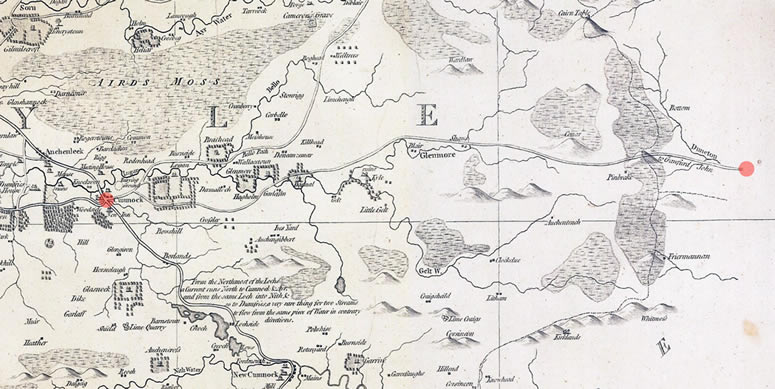
Investigation on the ground, and examination of old maps, has resulted in several miles of the old road being recognised and identified. Considerable sections of this toll road have been incorporated in more modern roads as these gradually developed. For instance, the present Townhead Street is exactly on the line of the 18th century road which, at that time was the only exit from Cumnock, towards the east and the south.
The old road re-appears behind Barshare School, and passes behind the foundation stones of Drumbrochan Cottage - latterly the clubhouse of the now defunct Cumnock Golf Club. It can clearly be seen circling the hill, and entering the area known to older Cumnock people as “The Stagecoach Road”, which proceeds in an almost straight line to the present Logan-Netherthird road. The continuation of the road line, across the modern road is the road towards Meikle Auchengibbert Farm road, where, after about 400 yards, at a sharp right-turn of the farm road, it takes a sharp left turn on to Boylston Farm ground (Grid Reference NS596195). This aforementioned route is actually plotted on some modern O.S. maps, - e.g. the Explorer 327, and Landranger 71 maps.
On Boylston ground it is easily traced along a line of beech trees, turning right and then left before proceeding through Crosslar Farm ground. It eventually wended its way along the south bank of the Glenmuir Water - before fording the river on to Dornal Farm ground. It re-appears again, immediately behind Nether Guelt Farm, and it is clearly seen from the modern road, running parallel to it for over 400 yards. A line of beech trees marches along its northern edge here.
From Guelt Cottage the modern road appears to cover the toll road, down to Dalblair, behind which a section of it vanishes, presumably washed away over the years as it climbed the Bank, (a fairly high escarpment, now mainly wooded). The road from Dalblair to Glenmuirshaw (which is now exceedingly rough and probably not suitable for ordinary cars) is almost certainly the route of the toll road. At Glenmuirshaw Farm (now a dilapidated ruin), the very rough, stony road gives way to a grassy track, which proceeds eastwards for about a mile, where, due to farm tractors and shepherds’ quad bikes, its course has been obliterated. However, a very small waterway, often dry, described on the maps as Peat Syke, reveals the remains of a very low bridge. This is very close to Polwhannon Burn.
Here, for the next mile or so, the trail runs cold! We have to remember that the topography of the area may well have changed considerably in 230-odd years. We are approaching an area of comparatively modern forestry, which is seamed by not a few forest roads, any of which could probably have been laid on the line of the old road, before tree-planting commenced. The general line of these roads is north-east, and the probable line runs south of Pinbreck Hill, and to the north of Three-shire Hill. It then runs towards Auchendaff, where the old road is very obvious and negotiable on bicycle or on foot. Further on it reaches, via later modern forest/farm roads, Glentaggart Farm, which is about 3 miles south of the village of Glespin.
Close examination of sections of the old road reveal that it is about 9 feet wide. Its base and sides are constructed of largish stones, covered by smaller aggregate and grit, - rather like our modern forestry roads.
Charges (tolls) were levied on horses, ponies, carts and cattle being driven along these roads, of course, and these were collected at the toll-houses. We have evidence of these toll-houses, even today, in the names of Logan Toll and Moat Toll. Other toll-houses were to be found at Garrallan, Sykeside, Polquhap, Mossback, and in the centre of Cumnock, at the corner of the modern Ayr Road and Glaisnock Street.
Enquiries have been made to Biggar Museum, in the hope of discovering that someone had been making similar investigation of the road from Crawfordjohn to Cumnock.
Unfortunately, there is no record of any such investigation.
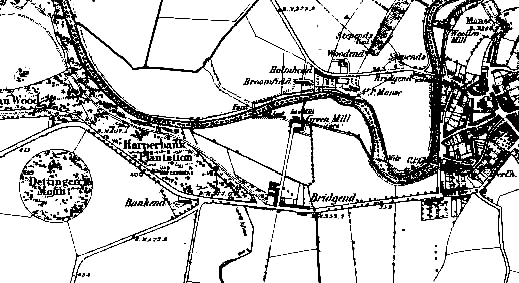 Researched by George Scott
Researched by George Scott
About half a mile west of Cumnock, at the intersection of the A70 and A76 roads, the road-signs inform us that we are approaching “The Dettingen Roundabout”. Many motorists must puzzle over this name and its origin, for Dettingen is a village in Germany!
Its connection with Cumnock is the battle which took place in Bavaria on 27th June, 1743, - a battle which involved some of our local aristocracy., - the Earl of Dumfries and the Earl of Stair. They were in the British army which, along with other forces from Hanover and Austria, were supporting the claim of Maria Theresa and her husband to the Imperial Crown of Austria. The entire allied force was under the command of the Earl of Stair, although when the British King George II appeared on the scene, nominal command would revert to the monarch. This was the last occasion when a British king would appear on a field of battle.
The enemy force were the French, whose invasion of Germany in 1740 led to the War of Austrian Succession (1740-48). The French under the command of Adrien-Maurice, Duc du Noilles (1678-1776) - were defeated by the allied force.
To commemorate this famous victory, two circular woods were planted on the return home of the Earl of Dumfries. One, - Dettingen Wood, is only 100 yards to the west of the roundabout. It lies in the angle between the Cumnock-Ayr road, and the Cumnock-Skares road. The other, named Stair Hill, is a mile or so uphill, near the old Dumfries House Station on the now dismantled A. & C. railway. Both woods were sited to represent the positions of the British forces at the start of the battle. It is reported that, at one time, a similar wood was planted within the grounds of Stair House.
After his return from the wars, the Earl of Stair appears to have devoted some of his time to agricultural reform. Warrick in his “History of Cumnock” reports that the Earl of Stair was "the first Scotsman to plant turnips and cabbages in fields upon a large scale" (Thomson`s "History III., p.410).
Footnotes :-
(1) The village of Dettingen lies on the River Main, 21 miles north-east of Darmstadt, near Frankfurt.
(2) As another celebration of the British victory, HANDEL composed “Dettingen Te Deum and Anthem“. (1743). First sung at Chapel Royal, St. James’s, November, 1743. Anthem’s text begins “The King shall rejoice”






